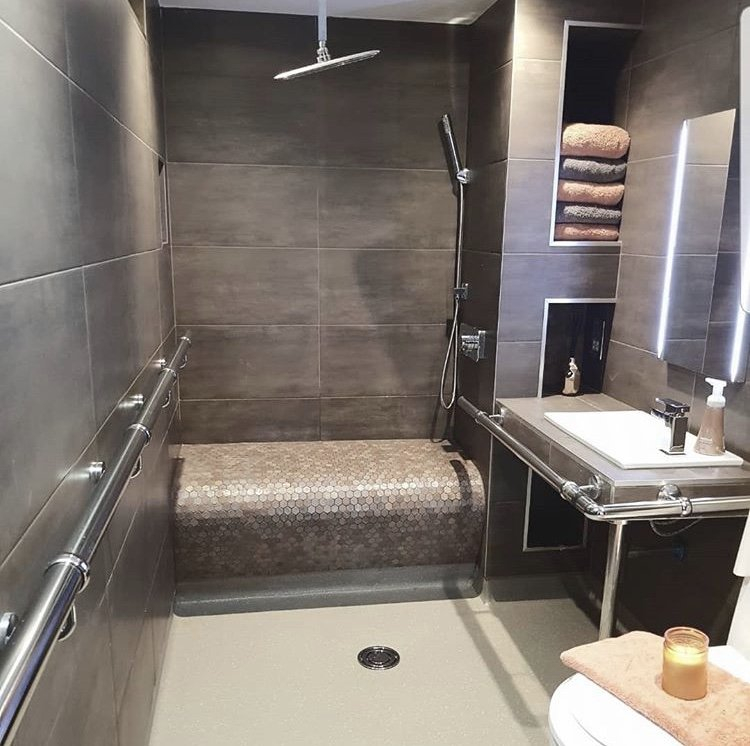Features of your home that make life easier
Options

laura222
Online Community Member Posts: 82 Empowering
Hello!
I'm currently planning some renovations to my house and so want to take this opportunity to introduce as many features that will make my life easier as someone with limited mobility, but will also be beneficial for people with different needs as far as possible. I'm aiming for a universal design kind of approach.
My physical mobility is deteriorating and so I'm likely to need to use my wheelchair more often in the future. So it would be really helpful if anyone could share with me some tips about how to set up my home with wheelchair use in mind. I'm most likely to be using a manual wheelchair inside, and my Mum who will be visiting (once we actually have an accessible house!) uses a powerchair.
I've been thinking about things like pocket-doors, roll-up kitchen cabinet doors, a shallower kitchen sink etc.
What are the things around your home that make life easier for you?
I'm currently planning some renovations to my house and so want to take this opportunity to introduce as many features that will make my life easier as someone with limited mobility, but will also be beneficial for people with different needs as far as possible. I'm aiming for a universal design kind of approach.
My physical mobility is deteriorating and so I'm likely to need to use my wheelchair more often in the future. So it would be really helpful if anyone could share with me some tips about how to set up my home with wheelchair use in mind. I'm most likely to be using a manual wheelchair inside, and my Mum who will be visiting (once we actually have an accessible house!) uses a powerchair.
I've been thinking about things like pocket-doors, roll-up kitchen cabinet doors, a shallower kitchen sink etc.
What are the things around your home that make life easier for you?
2
Comments
-
Hi @laura222
Good Afternoon & Welcome it’s great to meet you today ?
I’m one of the Community Champion’s here at Scope.
I am very very happy in helping you with your current project.
My current house is fairly old & very small.
I currently use ramps over the door frames.
We had a stairlift fitted some years back.
There was talk off having a “Through Floor Lift” but that was too expensive in the end.
Please please let me know if you need any further help??????
@steve51
0 -
Hi and welcome to the community, as a full time wheel chair user I live in a bungalow which obviously helps but other things I find useful or things i find difficult as as below
Laminate flooring throughout much easier for getting about and also easy to clean
Worktop height , needs to be lower than normal, and obviously cupboard height, oven well positioned
Anything that can be remote control operated eg lights, curtains
Wet room or a shower can sit in chair and also bath lift if have a both
Contact local council about assisted bin collection
Cant think of anything elser at moment will add later if I think of anything0 -
Walk in shower
0 -
Thanks very much, these are great to know. I'm looking in to how I can get some different levels of worktops in the kitchen since I'm sometimes standing, sometimes wheelchairing.
Laminate flooring is a good tip @janer1967 - thanks!
0 -
A friend of mine had his doorways widened, bit expensive though to be honest. Also raised electrical wall sockets.
(Should be done before laminate flooring)1 -
I have an Alexa. It can be linked up to lights and plugs which can make it all voice activated.
 2
2 -
Its a good while since I was on top of this. Research is your best bet. Habinteg began the design of accessible housing. Other, notably Greenwich, improved, e.g. not settling for the building standards idea of wheelchair accessible doors, because many people need bariatric, or become in need of frequently going in and out on a trolley or possibly a reclined chair due to spine etc.
You are right to think of different working surfaces. That is a typical example of where councils, for instance, have a one size fits all tickbox, lamentably for ugly institutional grab rails under the heading of aid and adaption grants. One woman in a council house was appalled when, ignoring her protests, council workmen ripped out all the lower cupboards, the only ones she could reach. They told her that, because she used a wheelchair, she needed to get it under all the worktops!!
At disability exhibitions, there are kichens to dream of, but too dear, and mainly not really necessary. The point someone has made, getting everything automated, is good. Bear in mind if you have spells in bed, you want bed to be the best room in the house, but also you want every door and light and curtain control and all your tech to be there. Make sure if you have any electrical work, the electrician at the same time provides extra capacity at the consumer unit, so if in future you are running twenty times more electrical gadgets than other users, you won't overload.
One thing is try and think ahead, in case things change. Another I'm keen on is, every chance there is, use floor to ceiling windows or glass doors, with balconies, especially where there's a view either of the garden or the street, but in any case to allow through- draughts in heatwaves and light from all angles.. Spending lots of time indoors makes natural daylight and not feeling imprisoned important. Often, people are sitting down or even lying down. It's no use to them if they need to stand by the window to see out. For the same reason, balconies should be see through. Every possible window or glass door is best to have some way to put plants outside, plus squirrel proof bird feeders.
The silly thing is, almost everything that makes a place sensible for disability also makes it perfect for everyone else. E.g. who hates daylight and loves poky high up mean little windows? Nobody but builders. Who loves the most narrow doors, so a mum with a twin buggy can't get in, nor can the furniture removals, or the ambulance stretcher crew,? Nobody but builders.
Theres a lot else, such as figuring turning circles, and ideally doing away with radiators because they take up space and get bashed (Never have them under windows of course. That suits nobody but builders.) A secure porch can be useful where a muddy wheelchair can wait, and an electric one can charge, but not insecure or in the view of anyone who might try stealing it of course.0 -
Hi @laura222. We had some blogs on this last year that might be of interest to you, including: Our house just the way we like it where Sandra shows her 'passion for contemporary accessible living; showing everyone that an adapted home doesn’t have to look like a nursing home or an institution.'

1 -
Ooooh that's brilliant thanks Adrian. Not institutional at all.
I did once do a ramp as a sort of garden design feature forming a circle where the centre was gravel for parking, the corners were planting, and the front path swept in a gentle slope so it took the entire garden and most of the side of the house, to reach the side entrance and avoid two steps.
One thing I would consider is avoiding the institutional look in just the way shown for the bathroom. There is a chrome rail to double as what looks like a a decorative feature plus towel rail, but it also does work as a continuous grab rail. Elsewhere in the house, it's possible to have something similar, but instead of a rail, which might look institutional, having the 'grab' be part of a narrow continuous shelf, as something to lean on, for 'furniture walkers'
i.e. people who need a bit of support and a bit of reassurance about balance. The way it works is a cross between those Victorian dado rails that ran round every room, at elbow height, and a shallow boxed in radiator . It looks like, and can be, concealed cupboards, or concealed wiring and ducting and heating and lighting.
Ceiling lights are a big thing to consider banning, for o.p. and for anyone re-designing with an electrician. When the bulb or shade or fitting need changing or even cleaning, someone must climb a step-ladder. That cannot make sense. Ideally avoid even ordinary conventional wall lights, if it is inaccessible or fiddly or needs tools. One thing to consider is full spectrum daylight bulbs in living rooms, so on gloomy winter days you get your own sunshine. I have used extremely cheap standard lamps from argos so I can change the position and combination for different effects, but cleaning or changing bulbs is easy by just leaning them over to the right level. But the cheapest full spectrum is a bulb that fits into an ordinary neon strip light fitting placed on top of the ordinary fitted kitchen units. It does mean someone has to climb up to put it there, but it doesn't need to be an electrician, and those bulbs seem to last forever.0 -
Probably everything has been covered but this is what I would need (some of which I have).......
Wet room (for showering) but some things vary from person to person so you need an assessment.
Elbow operated toilet.
Widened doorways with large easy handles on the correct side.
Some way to negotiate stairs (if you have them).
All sockets and light switches moved to mid range height.
Shelves at mid range height.
Lower kitchen worktops and more mid range height storage.
If you can transfer then possibly an electric riser recliner and electric bed, if not then a hoist or two.
Something to collect mail and keep it a reachable height.
There are other complications such as the type of light fittings, my place has a strip light in the kitchen which I'd have had trouble with when healthy. Fortunately the Council changed it for me (I live in a council bungalow). I have an outside light that I can't use because the bulb went and the Council wouldn't touch it. So you need to have access to someone to do this sort of job and other jobs if things break down. Simple things sometimes like changing clock batteries, lol! Other things might be needed if you have pets.
None of this stuff is cheap though and although I should be moved I get some of the stuff done thrown back at me as "how they have tried to help". I can't move (even though I have a report saying this place is inappropriate) because I cannot follow the moving procedures and I haven't been confined in hospital long enough for them to override the system.
Hope this helps and if I think of anything else I'll add it later.
TK0 -
Tk has added good points. Don't forget if theres a chance a person may want two wheel-chairs, one for indoors, there needs to be a way to transfer, alone If its a side to side, that needs considering in plans for storing and charging electric chairs.
Loo transfer has similar problems, if someone cannot stand independently. Loos are mega important. The Japanese often fit all singing all dancing automatic wash/ dry loos, as standard. That beings prices down. But even if it costs a lot, the outlay to achieve independence in the loo may be worthwhile.
P.S TK, as often, Im a bit cross on your behalf. For heavens sake the council has the public duty and the service provider duty and the landlord duty, regarding things like your faulty outside light. For safety, you need your outside light to be functioning. As a reasonable adjustment, they should help you, unlike other tenants who are non disabled . They can legitimately be told to climb a ladder. You can't.0 -
Thanks @newborn but our council is mostly unhelpful which is why I recently got a phone call from my Housing Officer after I chased up an inquiry in which he was supposed to call me and didn't. His words were "Stop calling us and wasting our time". I kid you not.
TK0
Categories
- All Categories
- 15.3K Start here and say hello!
- 7.2K Coffee lounge
- 87 Games den
- 1.7K People power
- 117 Announcements and information
- 24.2K Talk about life
- 5.8K Everyday life
- 413 Current affairs
- 2.4K Families and carers
- 868 Education and skills
- 1.9K Work
- 525 Money and bills
- 3.6K Housing and independent living
- 1K Transport and travel
- 884 Relationships
- 256 Sex and intimacy
- 1.5K Mental health and wellbeing
- 2.4K Talk about your impairment
- 863 Rare, invisible, and undiagnosed conditions
- 923 Neurological impairments and pain
- 2.1K Cerebral Palsy Network
- 1.2K Autism and neurodiversity
- 39.5K Talk about your benefits
- 6K Employment and Support Allowance (ESA)
- 19.6K PIP, DLA, ADP and AA
- 8.2K Universal Credit (UC)
- 5.7K Benefits and income





